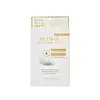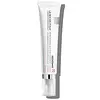What's inside
What's inside
 Key Ingredients
Key Ingredients

 Benefits
Benefits

 Concerns
Concerns

 Ingredients Side-by-side
Ingredients Side-by-side

Sodium Hyaluronate
HumectantSucrose
HumectantAscorbyl Glucoside
AntioxidantCyclodextrin
AbsorbentWater
Skin ConditioningGlycine Soja Oil
EmollientSodium Hydroxide
BufferingPropylene Glycol
HumectantAllantoin
Skin ConditioningPolysorbate 80
EmulsifyingRetinol
Skin ConditioningPanthenol
Skin ConditioningAcetyl Octapeptide-3
HumectantCapsicum Frutescens Fruit Extract
Skin ConditioningArginine/Lysine Polypeptide
Skin ConditioningBHT
AntioxidantWater
Skin ConditioningIsostearyl Neopentanoate
EmollientGlycerin
HumectantOctyldodecanol
EmollientPropylene Glycol
HumectantPentylene Glycol
Skin ConditioningAcrylamide
Sodium Acryloyldimethyltaurate Crosspolymer
Emulsion StabilisingVp/Va Copolymer
Cetearyl Alcohol
EmollientGlycine Soja Oil
EmollientTriethanolamine
BufferingIsohexadecane
EmollientSodium Hyaluronate
HumectantRetinol
Skin ConditioningRetinyl Linoleate
Skin ConditioningAdenosine
Skin ConditioningCapryloyl Salicylic Acid
ExfoliatingCaprylyl Glycol
EmollientPolysorbate 80
EmulsifyingPhenoxyethanol
PreservativeParfum
MaskingWater, Isostearyl Neopentanoate, Glycerin, Octyldodecanol, Propylene Glycol, Pentylene Glycol, Acrylamide, Sodium Acryloyldimethyltaurate Crosspolymer, Vp/Va Copolymer, Cetearyl Alcohol, Glycine Soja Oil, Triethanolamine, Isohexadecane, Sodium Hyaluronate, Retinol, Retinyl Linoleate, Adenosine, Capryloyl Salicylic Acid, Caprylyl Glycol, Polysorbate 80, Phenoxyethanol, Parfum
 Reviews
Reviews

Ingredients Explained
These ingredients are found in both products.
Ingredients higher up in an ingredient list are typically present in a larger amount.
Glycine Soja Oil comes from the soybean. Glycine Soja is native to eastern Asia.
Soybean oil is an emollient. It is rich in antioxidants and fatty acids including palmitic, stearic, oleic, and linoleic acids.
As an emollient, the fatty acids in soybean oil helps keep your skin soft and hydrated. It does so by creating a film on top that traps moisture in.
Soybean oil is also rich in vitamin E, a potent antioxidant. Vitamin E is also anti-inflammatory and provides a soothing effect.
Studies show soy may help fade hyperpigmentation from UVB. It does so by disrupting the melanin process from UVB induced skin inflammation.
This ingredient may not be malassezia folliculitis, or fungal-acne, safe.
Soybeans are rich in proteins and are part of the legume family. Foods made with soybeans include tofu, soymilk, edamame, miso, and soy sauce.
Learn more about Glycine Soja OilPolysorbate 80 is a surfactant and emulsifier. It is used to keep ingredients together, and prevent oils and waters from separating.
It is made from polyethoxylated sorbitan and oleic acid. This ingredient can be found in cosmetics, foods, and medicine. It is water-soluble.
Polysorbate 80 may not be fungal acne safe.
Learn more about Polysorbate 80Propylene Glycol is an odorless, colorless liquid. As a humectant, it helps skin retain moisture. It also aids in delivering active ingredients.
Another role of this ingredient is preventing a product from melting or freezing. Propylene glycol also adds antimicrobrial properties to a product, elongating product lifespan.
This ingredient is considered an organic alcohol and commonly added into both cosmetics and foods.
Those with sensitive skin or conditions may develop a rash when using this ingredient.
Learn more about Propylene GlycolRetinol is a gold-standard ingredient for anti-aging. It is a form of Vitamin A and belongs to the class of retinoids that also includes tretinoin.
Why is retinol famous?
It has the most scientific studies backing up its skin benefits out of all the non-prescription ingredients.
Retinol is proven to:
This is why retinol is effective at removing wrinkles, fading dark spots, treating acne, and reducing the appearance of pores.
Studies show retinol is less effective when exposed to UV. Be sure to look for appropriate packaging to keep your retinol potent (similar to Vitamin C).
Using retinol or any retinoids will increase sun-sensitivity in the first few months. Though studies show retinoids increase your skin's natural SPF with continuous use, it is best to always wear sunscreen and sun-protection.
We recommend speaking with a medical professional about using this ingredient during pregnancy.
Retinol may cause irritation in some people, so be sure to patch test. Experts recommend 'ramping up' retinol use: start using this ingredient once a week and work up to using it daily.
Read about Tretinoin
Learn more about RetinolSodium Hyaluronate is hyaluronic acid's salt form. It is commonly derived from the sodium salt of hyaluronic acid.
Like hyaluronic acid, it is great at holding water and acts as a humectant. This makes it a great skin hydrating ingredient.
Sodium Hyaluronate is naturally occurring in our bodies and is mostly found in eye fluid and joints.
These are some other common types of Hyaluronic Acid:
Learn more about Sodium HyaluronateWater. It's the most common cosmetic ingredient of all. You'll usually see it at the top of ingredient lists, meaning that it makes up the largest part of the product.
So why is it so popular? Water most often acts as a solvent - this means that it helps dissolve other ingredients into the formulation.
You'll also recognize water as that liquid we all need to stay alive. If you see this, drink a glass of water. Stay hydrated!
Learn more about Water